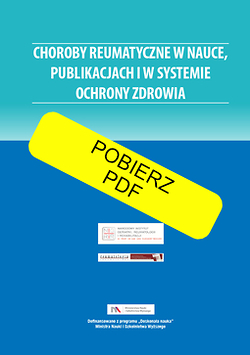|
2/2005
vol. 43
LIST DO REDAKCJI/LETTER TO THE EDITOR
Etiology of enhanced body temperature in patients admitted due to fever of unknown origin: analysis of 100 consecutive cases
Aneta Franczak-Drygalska
,
Katarzyna Jankiewicz-Ziobro
,
Online publish date: 2005/04/28
Get citation
Dear Sirs,
Fever can be defined as a body temperature higher than 38.3°C [2]. Regular temperature should be 36.6°C but it can fluctuate depending on the place and time of measurement. An increase in temperature may be due to many internal and external factors. Fever-inducing substances are called pyrogens. The most common pyrogens are bacterial endotoxins, cytokines such as interleukin-1, tumor necrosis factor-a, interleukin-6 and interferons. Common occurrence of these pyrogens is the reason why fever is one of the most common symptom in adult patients in outpatient clinics. Most cases of febrile conditions are easy to diagnose. Careful history taking and physical examinations are enough to know the cause of the fever. Sometimes fever higher than 38.3°C on several occasions lasted at least 3 weeks without detectable etiology and then it is called fever of unknown origin (FUO).
FUO was described for the first time by Petersdorf [7]. Later the FUO definition was modified by Durack and Street [3] who classified FUO into four types: classic, nosocomial, immune deficiency-related, and human immunodeficiency virus-related. The definition and etiology of the latter three types is rather well-known and it is difficult to consider them as FUO. Classic FUO is the most common type of FUO in inpatients and outpatients. The most common causes of the classic FUO are infections, malignancy and systemic diseases of the connective tissue (so-called collagen diseases).
The study was designed to analyze cases of fever in patients hospitalized in the Department of Internal Medicine and Rheumatology, Medical University of Silesia in Katowice admitted with a preliminary diagnosis of FUO.
One hundred consecutive cases of patients with classic FUO admitted from January 1, 2004 to June 30, 2004 were analyzed. The group consisted of 26 men and 74 women. Patients with neutropenia, HIV infection and those with nosocomial infections were excluded from the study.
The cause of FUO was revealed in 95 patients, and the remaining 5 ones were diagnosed as FUO after hospitalization. Table 1 summarizes causes of fever in our patients.
Systemic inflammatory connective tissue diseases were the most common cause of FUO in patients referred to the hospital as FUO (35%) in the investigated patients. Together with vasculitis they account for almost half of the patients. The cause of FUO in the remaining 3 cases was related to a great variety of etiological factors as summarized in Table 1. Infections are considered to be the most common cause of FUO [4, 8] although in our study infections have been found to cause FUO only in 7 patients. Despite several diagnostic efforts (blood cultures, urinary cultures, immune tests, x-ray studies, ultrasonography, computer tomography, magnetic resonance) in 5 cases of FUO the etiology of fever remained unknown.
Rheumatic diseases have been listed as the third cause of FUO and recently as the second cause [6]; in our patients they were found to be the most common cause in the patients’ group with FUO. Fourteen patients were diagnosed as rheumatoid arthritis. Still’s disease, one of the well-known causes of FUO [5] was noted only in 1 patient. Systemic lupus erythematosus was the most commonly diagnosed systemic connective disease (8%), often described in literature as the disease characterized by fever as one of the first symptoms [1]. Fever in patients with systemic lupus erythematosus can be found during several months without any other symptoms of the disease. Other rheumatic diseases often diagnosed in the investigated patients were seronegative spondyloartropathies (7%), unclassified connective tissue diseases (5%), polymyositis (2%), overlap syndromes (2%), systemic sclerosis, dermatomyositis, Sjogren’s syndrome in 1%. No case of temporal arteritis was noted although the disease is described in literature as a common cause of FUO [8].
Diagnostics of fever is a difficult and expensive medical problem. It is necessary to use many investigations and methods to diagnose FUO. Infections, neoplastic diseases and rheumatic diseases were shown to be the most common causes of FUO. At present, an increased incidence of rheumatoid diseases as a cause of FUO is observed. This phenomenon has been confirmed in our study.
References
1. Beyan E, Uzuner A, Beyan C. An uncommon cause of fever in the elderly: late-onset systemic lupus erythematosus. Clin Rheumatol 2003; 22: 481.
2. Cherry DK, Woodwell DA. National Ambulatory Medical Care Survey: 2000 summary. Adv Data 2002; 328: 1.
3. Durack DT, Street AC. Fever of unknown origin – reexamined and redefined. Curr Clin Top Infect Dis 1991; 11: 35.
4. Knockaert DC, Vanderschueren S, Blockmans D. Fever of unknown origin in adults: 40 years on. J Intern Med 2003; 253: 263.
5. Mert A, Ozaras R, Tabak F, et al. Fever of unknown origin: a review of 20 patients with adult-onset Still’s disease. Clin Rheumatol 2003; 22: 89.
6. Öztürk MA, Kiraz S, Ertenli I, et al. Rheumatic diseases as causes of fever of unknown origin: an update of classic data. Clin Rheumatol 2004; 23: 90.
7. Petersdorf RB, Beeson PB. Fever of unexplained origin: report on 100 cases. Medicine 1961; 40: 1.
8. Roth AR, Basello GM. Approach to the adult patient with fever of unknown origin. Am Fam Physician 2003; 68: 2223.
Copyright: © 2005 Narodowy Instytut Geriatrii, Reumatologii i Rehabilitacji w Warszawie. This is an Open Access article distributed under the terms of the Creative Commons Attribution-NonCommercial-ShareAlike 4.0 International (CC BY-NC-SA 4.0) License (http://creativecommons.org/licenses/by-nc-sa/4.0/), allowing third parties to copy and redistribute the material in any medium or format and to remix, transform, and build upon the material, provided the original work is properly cited and states its license.
|
|

 POLSKI
POLSKI












